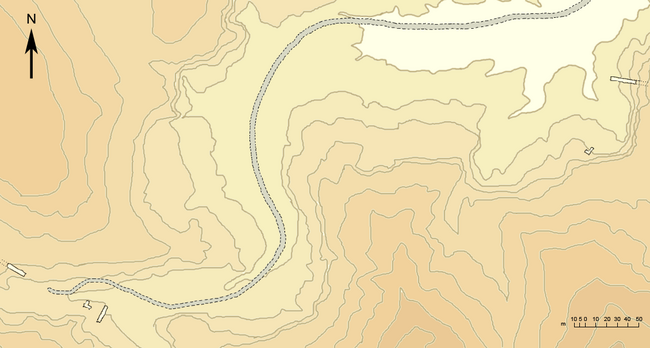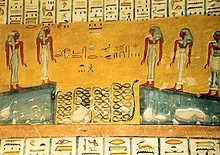Valley of the Kings
| The Valley of the Kings in hieroglyphics | ||||||||||||||||||||||||||||||
|---|---|---|---|---|---|---|---|---|---|---|---|---|---|---|---|---|---|---|---|---|---|---|---|---|---|---|---|---|---|---|
Pa-cher-aa-schepes-en-heh-en-renpetju-en-pera'a-anch-wedja-seneb-her-imentet-en-waset The great and lofty necropolis of the Pharaoh's millions of years - live, be safe and sound - in the west of Thebes |
||||||||||||||||||||||||||||||
The Valley of the Kings ( Arabic وادي الملوك, DMG Wādī al-Mulūk ; also Wadi el-Muluk , Bibân el-Molûk , Biban el-Muluk ) - located near the ancient Egyptian Thebes , today about 5 km northwest of the center of the Upper Egyptian city of Luxor - was a necropolis in ancient Egypt , in which to this day 64 tombs and pits were found. "KV65" is a radar anomaly that is interpreted as a grave, but has not yet been investigated further. In ancient Egypt, the Valley of the Kings was called Sechet-aat ( Sḫt ˁ3t ), "great field".
In the Valley of the Kings, the graves of the rulers of the New Kingdom (approx. 1550 to 1069 BC, 18th to 20th dynasties) can be found in particular . The valley is located in Thebes- West, opposite Karnak , on the edge of the desert and is lined with high mountains, namely the natural rock pyramid el Korn or el-Qurn ("the horn"). Almost the entire area of Thebes-West forms a huge necropolis. To the south of it lies the Valley of the Queens and in between the necropolises Dra Abu el-Naga , el-Chocha , al-Asasif , Deir el-Bahari , Sheikh Abd el-Qurna , Qurnet Murrai and Deir el-Medina with the "tombs of the nobles" .
Despite thousands of years of activity by grave robbers and looters , the Valley of the Kings still provided the Egyptologists of modern times with numerous extremely valuable excavation finds. Among other things, the largely intact grave of Tutankhamun ( KV62 ) was discovered here by Howard Carter in 1922 .
history

Various places in the Valley of the Kings have been inhabited by humans since at least the Middle Paleolithic .
antiquity
- The Thebes area was already used as a royal necropolis during the First Intermediate Period .
- In at-Tarif , northeast of the valley, there were Saff tombs of at least three kings of the 11th dynasty ( Antef I. , Antef II. , Antef III. ).
- Mentuhotep II built the first mortuary temple in the Deir el-Bahari basin .
- From the 18th dynasty onwards, numerous mortuary temples ( millions of years old) were built in the plain in front of the rocky mountains with the Valley of the Kings (east and west valley). These include the mortuary temples of:
- Theban princes of the 17th Dynasty were buried in Dra Abu el-Naga between at-Tarif and Deir el-Bahari.
- The first rulers of the 18th dynasty were probably also buried in West Thebes.
- The first clearly identified grave in the Valley of the Kings ( KV38 ) comes from Pharaoh Thutmose I (1506–1494 BC).
- Thutmose III. died on February 17, 1425 BC His grave ( KV34 ) lies in a narrow side gorge.
- The tomb of Pharaoh Ramses I , the founder of the 19th dynasty , is there, but his mummy is not.
- Seti I (reigned 1290–1279 BC), second ruler of the 19th dynasty, has his grave in the Valley of the Kings.
- Ramses XI. (20th Dynasty) was the last ruler to build his tomb in the valley, but did not use it. Many graves were looted in his time.
- A systematic grave opening and the search for gold took place as early as the 21st dynasty , probably ordered by the highest authorities.
- To protect the mummies, they were removed from the graves in the 22nd Dynasty under Scheschonq I and hidden in other graves.
- In the 3rd century AD, open graves were used as chapels by Coptic Christians.
Modern times
- In 1708, Father Claude Sicard visited the valley and correctly interpreted it as the burial place of kings. The next visitors were Richard Pococke (1739), James Bruce (1768) and William George Brown (1792), they located about 20 graves.
- With Napoleon's expedition to Egypt , the systematic search and opening of tombs began. On October 18, 1817, Giovanni Belzoni discovered the tomb of Seti I and entered it. Further grave openings were made by John Gardner Wilkinson , James Burton , Robert Hay and Karl Richard Lepsius .
- On March 9, 1898, Victor Loret opened the grave of Amenhotep II ( KV35 ) and found another hiding place with royal mummies there.
- Victor Loret, Harry Burton , Edward R. Ayrton and Howard Carter continued to dig successfully in the valley.
- On November 26, 1922, Howard Carter opened the tomb of Tutankhamun , KV62 , which was discovered on November 4 and only partially robbed .
- In 1995, the US Egyptologist Kent Weeks surprisingly exposed additional corridors in the KV5 system . The previous finds of 121 chambers and the symmetry of the complex mean that this is the largest tomb found in the valley so far. The research is not yet complete.
- In spring 2005 another burial chamber ( KV63 ) was discovered near Tutankhamun's grave . It contained seven wooden coffins of unknown origin and numerous sealed clay vessels.
- In January 2012, the grave chamber KV64 was opened by a research team from the University of Basel . The mummy of a “singer of Amun”, Nehemes Bastet, was found in a well-preserved wooden coffin.
The graves
Labelling
The tombs in the Valley of the Kings were numbered consecutively, with the letters KV (English abbreviation for Kings' Valley ) in front of the digits . The numbering goes back to John Gardner Wilkinson , who in 1827 wandered the valley with a paintbrush and a bucket of red paint, giving a number to every grave he found. He came to grave KV21.
A few graves are located in the western side valley and were given the English abbreviation WV (West Valley). These graves are also listed in the Theban Mapping Project with KV no. listed. The western valley is also known as Wadi el-Gurud ("Valley of the Monkeys") and refers to WV23 , the grave of Eje , which Giovanni Battista Belzoni named "monkey grave" due to the representations in the grave.
A total of 20 graves or pits that had been started were given letters instead of numbers, such as WVA or KVF . They are commonly referred to as embalming pits / caches .
Overview
tourism
The Valley of the Kings is one of the main draws for tourists in Egypt. Only a small part of the graves can be visited as a changing part is closed for conservation reasons. Some graves like that of Seti I ( KV17 ) have been closed to visitors for years. Tickets currently entitle you to visit three graves; the administration advises you to stay in each grave for only 10 minutes. An extra ticket must be purchased for the tomb of Tutankhamun.
Photography and filming were strictly restricted in the Valley of the Kings. Since December 2009 it is no longer allowed to take cameras into the valley. Since 2018, it has been possible to take photos without flash again by purchasing a photo permit at a price of around 15 euros.
In order to protect the royal tombs from further destruction and to preserve them for the future, it is planned to make true-to-original copies of the most important ones, which can be viewed instead. These include the grave of Seti I (KV17), the grave of Tutankhamun ( KV62 ) and the grave of Queen Nefertari ( QV66 ) in the Valley of the Queens.
Other attractions in the vicinity (some within walking distance) are:
- Deir el-Bahari
- Deir el-Medina (workers graves)
- Tombs of the Noble ( Qurna , Qurnet Murrai , al-Asasif , Dra Abu el-Naga )
- Medinet Habu
- Colossi of Memnon
- Ramesseum
- Valley of the Queens
- Temple of Hatshepsut
literature
- Aidan Dodson : After the Pyramids. The Valley of the Kings and Beyond. The Rubicon Press, London 2000, ISBN 0-948695-52-8 .
- Erik Hornung : Valley of the Kings. Artemis & Winkler, Düsseldorf 1999, ISBN 3-7608-0519-1 .
- Erik Hornung: The Valley of the Kings. Beck, Munich 2002, ISBN 3-406-47995-2 .
-
Bertha Porter , Rosalind LB Moss : Topographical Bibliography of Ancient Egyptian Hieroglyphic Texts, Statues, Reliefs, and Paintings. several volumes, 2nd edition, Griffith Institute, Oxford 1960 and 1964.
- Volume I Part 2: The Theban Necropolis. Royal Tombs and Smaller Cemeteries. 1964, Reprint 1999, ISBN 0-900416-10-6 , pp. 495-593. ( PDF ; 22.3 MB)
- Nicholas Reeves , Richard H. Wilkinson: The Valley of the Kings. Bechtermünz, Augsburg 2002, ISBN 3-8289-0739-3 .
- Kent R. Weeks , Araldo de Luca: In the Valley of the Kings - Of funerary art and the cult of the dead of the Egyptian rulers. Weltbild, Augsburg 2001, ISBN 3-8289-0586-2 .
- Richard H. Wilkinson , Kent R. Weeks: The Oxford Handbook of the Valley of the Kings. Oxford University Press, New York 2016, ISBN 978-0-19-993163-7 .
Web links
- Valley of the Kings
- The Theban Mapping Project - virtual visit to the royal tombs
Individual evidence
- ^ Alberto Siliotti: Guide to the Valley of the Kings. White Star, Vercelli 2000, ISBN 88-8095-496-2 , p. 12 f.
- ^ Rainer Hannig : The language of the pharaohs. Large concise Egyptian-German dictionary: (2800–950 BC) . (= Cultural history of the ancient world . Volume 64). von Zabern, Mainz 2001, ISBN 3-8053-1771-9 , p. 741.
- ^ Jürgen von Beckerath : Handbook of the Egyptian king names. (= Munich Egyptological studies. 20) Deutscher Kunstverlag, Munich a. a. 1984, ISBN 3-422-00832-2 , pp. 286-287.
- ↑ Reeves: The Valley of the Kings. 2000, p. 15.
- ↑ KV 5 (Sons of Rameses II). General Site Information. (No longer available online.) Theban Mapping Project, archived from the original on May 12, 2016 ; accessed on September 2, 2013 . Info: The archive link was inserted automatically and has not yet been checked. Please check the original and archive link according to the instructions and then remove this notice.
- ↑ Press release University of Basel: Short Preliminary Report January 2012: Discovery of a new tomb in the Valley of the Kings, KV 64 ( Memento of the original from April 29, 2014 in the Internet Archive ) Info: The archive link has been inserted automatically and has not yet been checked. Please check the original and archive link according to the instructions and then remove this notice. . from January 16, 2012
- ↑ Press release Zahi Hawass: Tourist Regulations ( Memento of December 14, 2009 in the Internet Archive ). dated December 13, 2009
- ↑ Press release Zahi Hawass: Tourist Regulations ( Memento of December 14, 2009 in the Internet Archive ). dated December 13, 2009
Coordinates: 25 ° 44 ′ 27 ″ N , 32 ° 36 ′ 7 ″ E









